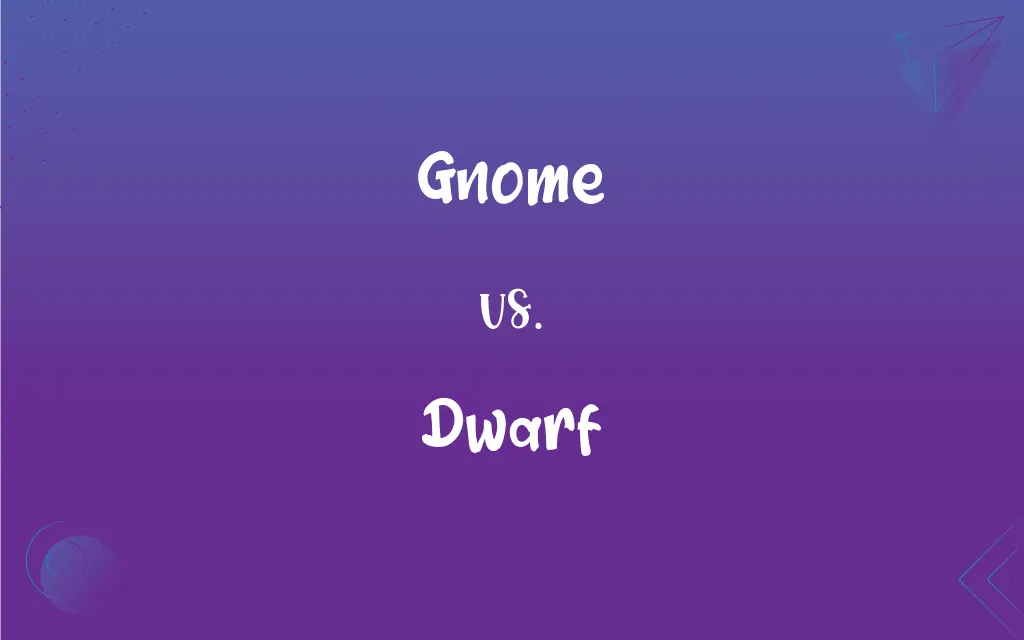Gnome vs. Dwarf: What's the Difference?
Edited by Aimie Carlson || By Janet White || Updated on October 6, 2023
Gnome is often depicted as a small, elder-like, and magical creature, while a Dwarf is typically portrayed as a short, sturdy being skilled in mining and metallurgy, often existing in a medieval fantasy context.

Key Differences
Gnome and Dwarf hold unique mythological standings. Gnomes are typically considered gentle and benevolent, commonly connected with the earth, and often said to live underground. Dwarfs, on the other hand, are sturdy, bold beings often associated with craftsmanship, especially metalwork, and might live in mountains or underground realms.
A distinctive visual comparison between Gnome and Dwarf manifests in their physical portrayals. Gnomes often carry a benign, often elderly visage, adorned with pointy hats, and might be involved in safeguarding treasures. In contrast, Dwarfs may exhibit strong, muscular forms, bearing weapons and armors indicative of their warrior and crafting attributes.
Gnome carries a multitude of cultural significances in various narratives. Often connected with gardening in modern depictions, they safeguard nature, and in some beliefs, provide protection and good fortune. Conversely, Dwarfs commonly emerge in myths and stories as incredible warriors or skilled blacksmiths, contributing dynamically in battles or adventures.
Despite surface similarities, Gnome and Dwarf cater to different symbolic meanings. Gnomes may symbolize protection and benevolence, often being mystically connected to the earth and elements. Dwarfs symbolize strength, endurance, and expertise in forging and fighting, being pivotal in numerous mythological wars and conflicts.
In literature and film, Gnome and Dwarf exhibit contrasting narratives. Gnomes might not be the central figures in epic tales or adventures but stand as symbols or secondary characters providing wisdom or aid. Dwarfs frequently hold pivotal roles in mythical stories
ADVERTISEMENT
Comparison Chart
Mythological Origin
Often related to elemental spirits and protection
Commonly linked to Norse and Germanic myths
Physical Appearance
Small, elderly, usually with pointy hats
Short, robust, often with beards and armor
Common Occupations
Keepers of treasures, guardians of nature
Blacksmiths, warriors, miners
Symbolic Meaning
Protection, benevolence, wisdom
Strength, craftsmanship, warrior spirit
Role in Narratives
Guiding spirits, secondary supportive characters
Often major characters in epics, warriors
ADVERTISEMENT
Gnome and Dwarf Definitions
Gnome
Gnomes are sometimes seen as symbols of good luck and protection in folklore.
People placed statues of a gnome in their gardens, hoping to bring fortune to their homes.
Dwarf
In mythology, dwarfs are commonly portrayed as strong, brave, and honorable beings.
In the heat of battle, the dwarf stood his ground, fearlessly facing the oncoming horde.
Gnome
A gnome is a diminutive spirit in Renaissance magic and alchemy.
The gnome silently watched over the blossoming garden, keeping it safe from harm.
Dwarf
In various stories, dwarfs are associated with crafting magnificent artifacts and weapons, blending magic and metallurgy.
The dwarf spent decades mastering the art of blending magic and metal, crafting artifacts of unimaginable power.
Gnome
In various tales, gnomes might have the power to move through the earth like a fish through water.
The gnome traversed beneath the soil, emerging miles away in an instant.
Dwarf
A dwarf is a mythical being of short stature, known for its skill in metalwork and combat.
The dwarf crafted a sword of unparalleled sharpness, embedding his skill into every swing.
Gnome
In modern culture, gnomes are often depicted as small, humanoid creatures that typically live underground.
The gnome hid from human eyes, secretly tending to the plants and animals in the night.
Dwarf
Dwarfs often dwell in mountainous realms or underground, living amongst precious stones and metals.
The dwarf navigated the deep, intricate tunnels with ease, calling the underground world his home.
Gnome
One of a fabled race of dwarflike creatures who live underground and guard treasure hoards.
Dwarf
Dwarfs may be depicted as social and community-oriented, often living in highly structured societies.
Within the dwarven community, every individual played a part, forging, fighting, or planning together in unity.
Gnome
In the occult philosophy of Paracelsus, a being that has earth as its element.
Dwarf
A person with a usually genetic disorder resulting in atypically short stature and often disproportionate limbs.
Gnome
A pithy saying that expresses a general truth or fundamental principle; an aphorism.
Dwarf
An atypically small animal or plant.
Gnome
A brief reflection or maxim; a pithy saying.
Dwarf
A small creature resembling a human, often having magical powers, appearing in legends and fairy tales.
Gnome
An elemental (spirit or corporeal creature associated with a classical element) associated with earth.
Dwarf
A dwarf star.
Gnome
One of a race of imaginary human-like beings, usually depicted as short and typically bearded males, who inhabit the inner parts of the earth and act as guardians of mines, mineral treasure, etc.; in modern fantasy literature and games, when distinguished from dwarves, gnomes are usually even smaller than dwarves and more focussed on engineering than mining.
Dwarf
To check the natural growth or development of; stunt
"The oaks were dwarfed from lack of moisture" (John Steinbeck).
Gnome
A person of small stature or misshapen features, or of strange appearance.
Dwarf
To cause to appear small by comparison
"Together these two big men dwarfed the tiny Broadway office" (Saul Bellow).
Gnome
The northern pygmy owl, Glaucidium gnoma, a small owl of the western United States.
Dwarf
To become stunted or grow smaller.
Gnome
A small statue of a dwarf-like character, often bearded, placed in a garden.
Dwarf
(mythology) Any member of a race of beings from (especially Scandinavian and other Germanic) folklore, usually depicted as having some sort of supernatural powers and being skilled in crafting and metalworking, often as short with long beards, and sometimes as clashing with elves.
Gnome
An upper atmospheric optical phenomenon associated with thunderstorms, a compact blue starter.
Dwarf
A person of short stature, often one whose limbs are disproportionately small in relation to the body as compared with typical adults, usually as the result of a genetic condition.
Gnome
A banker, especially a secretive international one.
The gnomes of Zurich
Dwarf
An animal, plant or other thing much smaller than the usual of its sort.
Dwarf tree
Dwarf honeysuckle
Gnome
An imaginary being, supposed by the Rosicrucians to inhabit the inner parts of the earth, and to be the guardian of mines, quarries, etc.
Dwarf
(star) A star of relatively small size.
Gnome
A dwarf; a goblin; a person of small stature or misshapen features, or of strange appearance.
Dwarf
Miniature.
The specimen is a very dwarf form of the plant.
It is possible to grow the plants as dwarf as one desires.
Gnome
A small owl (Glaucidium gnoma) of the Western United States.
Dwarf
(transitive) To render (much) smaller, turn into a dwarf (version).
Gnome
A brief reflection or maxim.
Dwarf
(transitive) To make appear (much) smaller, puny, tiny.
The newly-built skyscraper dwarfs all older buildings in the downtown skyline.
Gnome
A legendary creature resembling a tiny old man; lives in the depths of the earth and guards buried treasure
Dwarf
(transitive) To make appear insignificant.
Bach dwarfs all other composers.
Gnome
A short pithy saying expressing a general truth
Dwarf
(intransitive) To become (much) smaller.
Gnome
Gnomes are commonly depicted with pointy hats, perhaps illustrating their connection to magic and mysticism.
Wearing his pointy hat, the gnome whispered ancient spells to heal the dying plant.
Dwarf
To hinder from growing to the natural size; to make or keep small; to stunt.
Dwarf
An animal or plant which is much below the ordinary size of its species or kind.
Dwarf
A diminutive human being, small in stature due to a pathological condition which causes a distortion of the proportions of body parts to each other, such as the limbs, torso, and head. A person of unusually small height who has normal body proportions is usually called a midget.
Dwarf
A small, usually misshapen person, typically a man, who may have magical powers; mythical dwarves were often depicted as living underground in caves.
Dwarf
To hinder from growing to the natural size; to make or keep small; to stunt.
Even the most common moral ideas and affections . . . would be stunted and dwarfed, if cut off from a spiritual background.
Dwarf
To become small; to diminish in size.
Strange power of the world that, the moment we enter it, our great conceptions dwarf.
Dwarf
A person who is abnormally small
Dwarf
A legendary creature resembling a tiny old man; lives in the depths of the earth and guards buried treasure
Dwarf
Make appear small by comparison;
This year's debt dwarves that of last year
Dwarf
Check the growth of;
The lack of sunlight dwarfed these pines
FAQs
How are gnomes typically depicted?
Gnomes are often depicted as diminutive, elderly humanoids, wearing pointed hats and living underground.
Are gnomes real?
Gnomes are mythological creatures and are not considered real in the scientific community.
What cultures feature gnomes in their folklore?
Gnomes feature in European folklore, particularly in Renaissance magic and alchemy.
How do gnomes differ from dwarves in folklore?
While both are diminutive beings, gnomes are often associated with the earth and knowledge, whereas dwarves are linked to mining and craftsmanship.
Are garden gnomes inspired by mythical gnomes?
Yes, garden gnomes are decorative representations inspired by the folklore creatures.
Why is the "g" in "gnome" silent?
It's based on the word's historical pronunciation and the conventions of English spelling.
How are dwarves typically depicted in folklore?
Dwarves are often shown as stout, strong, bearded beings skilled in mining and metallurgy.
Do gnomes have any magical abilities?
In folklore, gnomes are sometimes attributed with magical abilities or knowledge of hidden treasures.
What is the plural form of "gnome"?
The plural form is "gnomes."
Are gnomes considered good or evil in mythology?
Gnomes are typically neutral or good in nature, often helping humans or keeping to themselves.
What is the origin of the word "Gnome"?
The word "gnome" is derived from the Greek word "gnomos," which means "thought" or "knowledge."
Which cultures feature dwarves prominently in their myths?
Dwarves are significant in Norse and Germanic mythologies.
Is "dwarf" used in modern terminology?
Yes, "dwarf" can refer to anything unusually small, like dwarf stars in astronomy, or to individuals with dwarfism.
Are dwarves real?
While dwarves as mythical beings aren't real, "dwarfism" is a medical term referring to short stature resulting from specific genetic or medical conditions.
How do dwarves relate to elves in folklore?
In some myths, dwarves and elves are distinct but related beings, with contrasting natures and domains.
What's the plural form of "dwarf"?
The plural can be "dwarfs" or "dwarves," though "dwarves" is popularized by Tolkien.
Are the dwarves in Tolkien's Middle-Earth inspired by traditional myths?
Yes, Tolkien's dwarves were influenced by Norse mythology, though he added his own unique lore.
Are dwarves portrayed positively in literature?
Depictions vary, but they're often shown as honorable, skilled, and wise, especially in modern fantasy literature.
What is the origin of the word "Dwarf"?
The word "dwarf" comes from Old English "dweorg" and has Germanic roots.
Do dwarves possess magic in myths?
In many stories, dwarves are known to craft magical items or possess innate magical abilities.
About Author
Written by
Janet WhiteJanet White has been an esteemed writer and blogger for Difference Wiki. Holding a Master's degree in Science and Medical Journalism from the prestigious Boston University, she has consistently demonstrated her expertise and passion for her field. When she's not immersed in her work, Janet relishes her time exercising, delving into a good book, and cherishing moments with friends and family.
Edited by
Aimie CarlsonAimie Carlson, holding a master's degree in English literature, is a fervent English language enthusiast. She lends her writing talents to Difference Wiki, a prominent website that specializes in comparisons, offering readers insightful analyses that both captivate and inform.































































